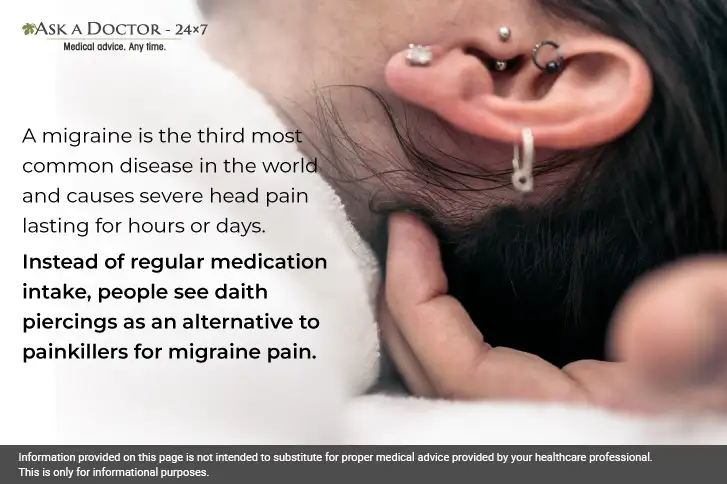Can Daith Piercing Help Managing Chronic Migraine?
If you suffer from chronic migraines, you've undoubtedly already tried a plethora of different treatments to relieve the excruciating headache agony. There are various ways to treat migraines including diet modifications, massages, Botox injections, and specialty products. Recently, one of the more unusual approaches is getting your ear's innermost cartilage fold pierced, known as a daith ear piercing. It is said to have numbing effects that help manage migraine pain.
The theory behind daith piercings for migraines is based on traditional Chinese medicine and acupuncture, which have been used for decades to treat a range of ailments, including pain and inflammation. Although, there is little scientific evidence to support the use of acupuncture for migraine. In some trials, acupuncture through daith piercing has been demonstrated to offer temporary relief from migraine symptoms.
Here in this blog, we are going to discuss daith piercing and its effects on migraine. Read on…
What is Daith Piercing?

What is a Migraine?
A migraine isn't your average headache. It is the most common disabling brain disorder. Chronic migraine is an intense headache episode that usually lasts for hours, at least 15 days per month.
Typically, migraine is associated with the following symptoms, such as:
- One-sided headache of moderate or severe pain intensity with pulsating quality
- Flashes of light
- Nausea and vomiting
- Blind spots in the eye (retinal migraine)
- Neck stiffness
- Tingling sensations in the arms and legs
- Heightened light and sound sensitivity
When it comes to treatment, not every therapy option will work for every person. Some of the options available to migraine sufferers include the use of:
- Drugs for the treatment and prevention of migraine attacks
- Transcranial magnetic stimulation
- Transcutaneous vagus nerve stimulation
- Acupuncture
It is important to understand that migraines are disruptive. They may disrupt your daily schedule and make it more difficult for you to fulfil your social and personal commitments. Hence, people are looking for alternative treatment options to cure migraine.
Can a Daith Piercing Help With Migraine Pain?

It is widely believed that the location of a daith piercing correlates to an acupuncture point that is used to treat migraine headaches. Hence, piercing this acupuncture point is considered to provide long-lasting pain alleviation. Daith piercings activate an inner ear acupressure point, which is also believed to be connected to the vagus nerve, which has a branch on the ear's surface, at the daith. Vagus nerve is one of the main nerves in the body that helps control pain and inflammation. It is believed that the stimulation of the vagus nerve not only reduces the transmission of pain signals but it also reduces the excitability of the cerebral cortex of the brain. However, scientists believe that daith piercing effects are just placebo, and there is no scientific evidence to claim the effectiveness of piercing in treating migraine.
Risks of Daith Piercing
Daith piercings are risky, just like any other type of body piercing. Because it's a small, curving piece of cartilage, it can be difficult to pierce, and most people don't change the jewelry once it's done. It can also take months to heal and become infected if not pierced or cared for properly. Among these threats are some that are more dangerous than others, such as:
- Infections with bacteria, yeast, hepatitis, HIV, or tetanus during the healing process
- Bacterial infections that develop after the healing process has finished
- Allergic response (to jewelry)
- Bleeding from the site
- Nerve damage, including loss of sensation in the area
- Swelling and discomfort
- Scarring or keloids
Hence, reducing the frequency, duration, or intensity of migraine attacks is the goal of preventive therapy.
Conclusion
Many alternative therapies are usually observed viral on social media that claims to relieve headaches, but their effectiveness varies from person to person and may not be scientifically proven.
Daith piercing is also one of the highly recommended therapies these days for migraine. It involves getting a piercing done in the ear cartilage at the helix. Although some claim that daith piercing attempts to replicate acupuncture and reduce the symptoms of migraine, scientists believe it to produce only a temporary effect. Hence, it is always recommended to consult with a licensed Acupuncturist or Auriculotherapist before getting a daith piercing to treat a migraine.
If you have any questions related to curing chronic migraine or alternative therapies regarding treating recurrent headaches, you can Ask a Neurologist at Ask a Doctor - 24x7.
Recently Answered Queries Related to Alternative Therapies For Migraine
- Are Daith And Tragus Piercings Effective In Treating Migraine?
- Is Mild Swelling Post A Daith Piercing A Concern?
- Is Daith Piercing Advisable Over Tragus Piercing For Migraine Headaches?
- Is Daith Piercing Helpful In Reducing Migraines?
- Suggest Treatment For Migraine
- Suggest Treatment For Migraine And Persistent Cephalic Aura
- How Can Chronic Migraine Be Treated?
- Do Migraine Patients Become Unconscious At The Time Of Migraine Attacks?
Disclaimer: Information provided on this page is not intended to substitute for proper medical advice provided by your healthcare professional. This is only for informational purposes.
Ask a Specialist
Recent Questions


